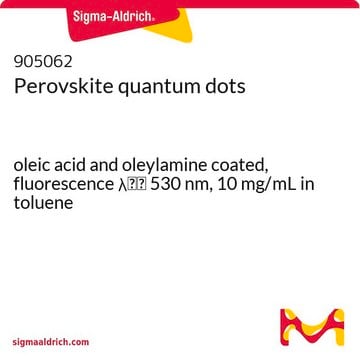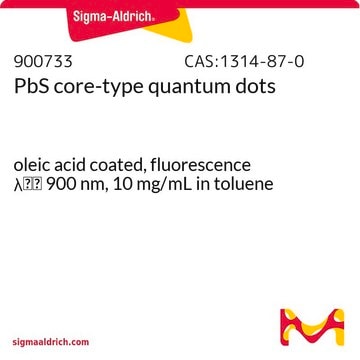These Quantum Dots have a particle size range of 4.5 - 5.5 nm by TEM analysis.
776785
InP/ZnS quantum dots
stabilized with oleylamine ligands, fluorescence λem 650 nm, 5 mg/mL in toluene
Sinonimo/i:
Cadmium free core shell quantum dots, Cadmium free quantum dots, Core/Shell heavy metal free quantum dots, Fluorescent nanocrystals
Scegli un formato
About This Item
Prodotti consigliati
Livello qualitativo
Stato
liquid
Concentrazione
5 mg/mL in toluene
Fluorescenza
FWHM <70 nm, quantum yield ~25%
λem 650 nm
Temperatura di conservazione
2-8°C
Cerchi prodotti simili? Visita Guida al confronto tra prodotti
Categorie correlate
Applicazioni
Avvertenze
Danger
Indicazioni di pericolo
Consigli di prudenza
Classi di pericolo
Aquatic Chronic 3 - Asp. Tox. 1 - Carc. 1B - Flam. Liq. 2 - Repr. 2 - Skin Irrit. 2 - STOT RE 1 - STOT RE 2 - STOT SE 3
Organi bersaglio
Central nervous system, Lungs
Classe di pericolosità dell'acqua (WGK)
WGK 3
Punto d’infiammabilità (°F)
43.0 °F
Punto d’infiammabilità (°C)
6.1 °C
Scegli una delle versioni più recenti:
Possiedi già questo prodotto?
I documenti relativi ai prodotti acquistati recentemente sono disponibili nell’Archivio dei documenti.
Articoli
Dye-sensitized solar cells as a promising, low-cost photovoltaic technology.
Professor Sharma and colleagues review the synthesis and applications of this novel material. This includes a discussion of the unique properties of quantum dots and their suitability for solar cell applications, along with common synthesis techniques used to develop these materials.
Professor Xiaohu Gao (University of Washington, USA) provides a overview of recent quantum dot (QD) advancements and their potential for advancing bioassay and bioimaging technologies.
Perovskite quantum dots research progresses overcoming challenges, enabling rapid development of light-emitting devices.
-
What is the average size of the QDs?
1 answer-
Helpful?
-
Active Filters
Il team dei nostri ricercatori vanta grande esperienza in tutte le aree della ricerca quali Life Science, scienza dei materiali, sintesi chimica, cromatografia, discipline analitiche, ecc..
Contatta l'Assistenza Tecnica.








